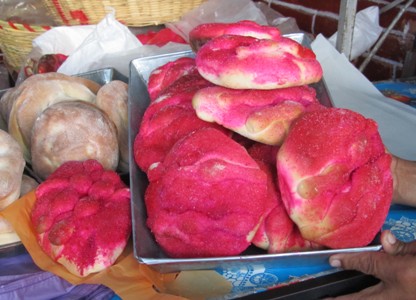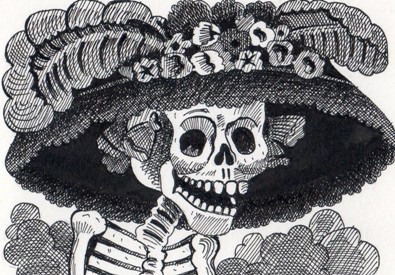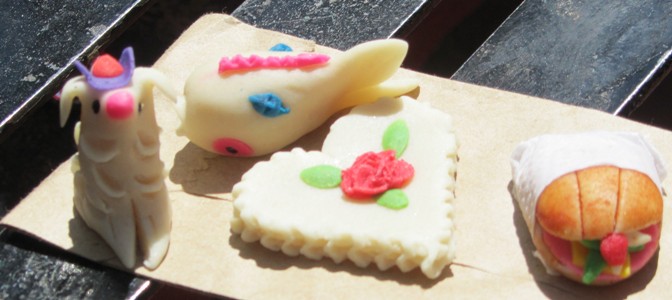Sweet Mexico - The Day of the Dead

The pretty colonial town of Taxco in the state of Guerrero began as a mining village in pre-Hispanic times and has lived through boom and bust over the centuries, the most famous surge of success being in the 1800s when an Aragonese immigrant, José de la Borda, was lucky enough to strike the fabulously rich Sán Ignacio seam of silver. The silver ran out long ago but the steep cobble-stoned streets in the historical centre are lined with “platerías”, silver workshops and retailers, and the whitewashed houses with their warm terracotta roofs sprawl higgledy piggledy up the side of a rugged mountain. The local fruit and vegetable market is approached via a precipitous staircase near the central plaza or “zócalo”, and a wander through the stalls entails plenty of climbing up and down, with the vendors setting out their wares on any flat piece of ground they can find, as well as on the countless flights of steps. Fresh produce, meat and fish, groceries, kitchenware and prepared dishes are all on offer, but for the past week, the stalls have been decorated with brightly coloured tissue paper cut-outs of pumpkins and skeletons and some very seasonal goods have made their annual appearance: “cempasúchil” or Aztec marigold, macabre skeleton dolls, round loaves of sweet yeasted bread decorated with bones fashioned from dough, little sugar and chocolate skulls and, in Taxco on this occasion, a very special bonbon made of pumpkin seeds – all of which herald the approach of the “Día de los Muertos” or Day of the Dead, one of the most important Mexican festivals.

Taxqueño Pán de Muerto © Isabel Hood
The Día de los Muertos actually spans two days, and on 1st and 2nd November every year, Mexicans throughout the country remember and honour their dear departed – children on the first day and adults on the second. Flower- and candle-bedecked altars are set out in the homes with photographs of the deceased, and in the evening the whole family gathers around the grave in the cemetery to celebrate. More candles are lit, the incense “copal” is burned, food and drink are set out, guitars are strummed and the “fiesta” lasts throughout the night.

Posada’s La Catrina © Philip Hood
The most famous symbol for the Day of the Dead is undoubtedly the macabre “La Catrina”, a fancily dressed female skeleton with a wide toothy grin under her flower and feather adorned hat, created by Mexican artist José Guadalupe Posada in the late nineteenth century – and the vendors of skeleton dolls of all sizes, shapes and attires do a roaring trade at this time of the year. The ghoulish sugar and chocolate skulls, with their glittering eyes and well-defined teeth, are another much loved seasonal treat; in the Taxco market, however, I recently found not only the traditional Day of the Dead bread or “Pán de Muerto” dyed a vibrant pink, but also another favourite delicacy, which truly shows off the Taxqueña women’s artistry and creativity: hand-made “alfeñiques”, small figurines fashioned out of a sugar and finely ground pumpkin seed paste. There are fish and piglets, birds and butterflies, hearts and crosses, fruit, sandwiches and bouquets of flowers.

Alfeñiques in Taxco © Isabel Hood
They are barely an inch high and yet beautifully sculpted, with touches of colour on fins and ears, wings and petals – and having bought a generous selection, I could barely bring myself to destroy them by sinking my teeth into them! The flavour is very sweet, with a hint of nuttiness, and while the outside is crisp, the centre is soft and slightly chewy. I have no doubt that a huge amount of patience is required to make them, but perhaps one day I will have a go in order to commemorate my own dear departed – after all, the numerous stall keepers I spoke to assured me that “se aprende”, one learns, and perhaps practice makes perfect.

The Día de los Muertos actually spans two days, and on 1st and 2nd November every year, Mexicans throughout the country remember and honour their dear departed – children on the first day and adults on the second. Flower- and candle-bedecked altars are set out in the homes with photographs of the deceased, and in the evening the whole family gathers around the grave in the cemetery to celebrate. More candles are lit, the incense “copal” is burned, food and drink are set out, guitars are strummed and the “fiesta” lasts throughout the night.

The most famous symbol for the Day of the Dead is undoubtedly the macabre “La Catrina”, a fancily dressed female skeleton with a wide toothy grin under her flower and feather adorned hat, created by Mexican artist José Guadalupe Posada in the late nineteenth century – and the vendors of skeleton dolls of all sizes, shapes and attires do a roaring trade at this time of the year. The ghoulish sugar and chocolate skulls, with their glittering eyes and well-defined teeth, are another much loved seasonal treat; in the Taxco market, however, I recently found not only the traditional Day of the Dead bread or “Pán de Muerto” dyed a vibrant pink, but also another favourite delicacy, which truly shows off the Taxqueña women’s artistry and creativity: hand-made “alfeñiques”, small figurines fashioned out of a sugar and finely ground pumpkin seed paste. There are fish and piglets, birds and butterflies, hearts and crosses, fruit, sandwiches and bouquets of flowers.

They are barely an inch high and yet beautifully sculpted, with touches of colour on fins and ears, wings and petals – and having bought a generous selection, I could barely bring myself to destroy them by sinking my teeth into them! The flavour is very sweet, with a hint of nuttiness, and while the outside is crisp, the centre is soft and slightly chewy. I have no doubt that a huge amount of patience is required to make them, but perhaps one day I will have a go in order to commemorate my own dear departed – after all, the numerous stall keepers I spoke to assured me that “se aprende”, one learns, and perhaps practice makes perfect.
You Should Also Read:
The Day of the Dead - Candied Pumpkin Recipe
The Day of the Dead in Mexico
Xocolatl, the Aztecs' Food of the Gods

Related Articles
Editor's Picks Articles
Top Ten Articles
Previous Features
Site Map
Content copyright © 2023 by Isabel Hood. All rights reserved.
This content was written by Isabel Hood. If you wish to use this content in any manner, you need written permission. Contact Mickey Marquez for details.


